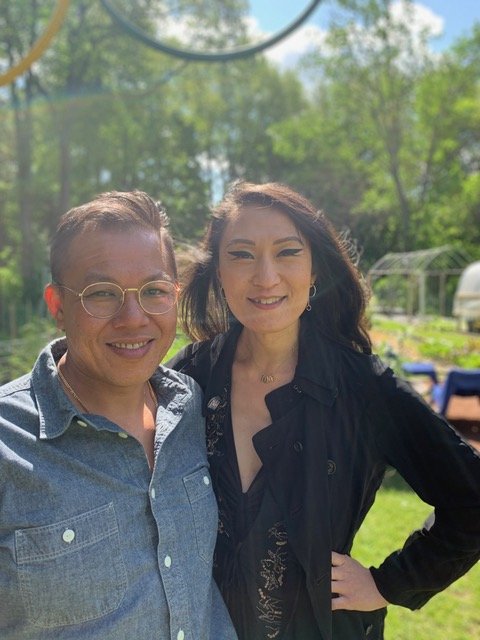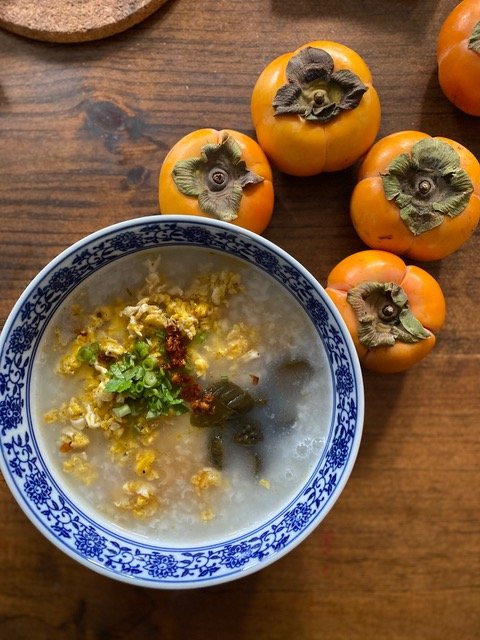
above: Cháo Trắng with peppered eggs and pickled cucumbers
Cháo Trắng: A Recipe for Togetherness
by Tu Le
Le’s recipe for Cháo Trắng can be found at the bottom of this page.
Simmering cháo (rice porridge) exudes the distinct Jasmine rice aroma that transports me back to my childhood. Nga, my mother, was the proprietor of care in our family. Her expression of care was demonstrated by her maternal instincts to channel her love. Traditions I learned and live, but didn’t fully understand until the loss of my mother in 2019.
I have never experienced a deep sense of emptiness until her loss. I’ve always thought of myself as extremely autonomous and able to get over many grief-stricken experiences, but this loss was different. I could no longer call to hear her voice and the wisdom she conveyed. At times I felt like I couldn’t move beyond the memories and the grief.
Days after her passing, our family gathered for a nourishing meal cooked by my oldest sister, Kieu Huong, and Aunt Nhung (see the video here). In grief, we were able to find comfort amongst each other and warmth in a comforting bowl of Cháo Ga (chicken). Four generations gathered in the small one bedroom bungalow to celebrate a woman who gave us all so much. Family was important to her and I know in that moment that my mother was proud.
Cháo played a role in comfort and healing throughout my life. In lieu of chicken soup for a cold, cháo was what was served on a sick day. Coupled with eucalyptus stems, and sometimes cupping, cháo was that simple sustenance that one needed when nothing else would stay down. When one of my sisters, or sisters-in-law, would give birth, my mom would serve them cháo trắng and stems to help cleanse their system. I observed this care from a distance, sometimes partaking because I was interested in learning.
My father instilled a sense of self and self-care into my being. “Con không biết, thì con học” (If you don’t know, then learn it) is what my father would say to me throughout my youth. I’ve put into practice these lessons, but the burden became a lot to carry throughout my adult life. I’ve had to learn that I can’t do it alone, but it took time to get there.
War and the loss of one’s home and country is foundational trauma that gets passed along with other traditions. Traditions are translated differently when you’re forced to flee and find refuge in a new an unfamiliar place. Choosing to keep rituals and traditions alive can be the only way a family can retain a sense of place and self. I’m sure my Maternal Grandparents learned from their parents and these get passed along to the generations that have followed.

My maternal great-grandmother, who lived to 104, flanked by my grandmother + grandfather, mid-1970s
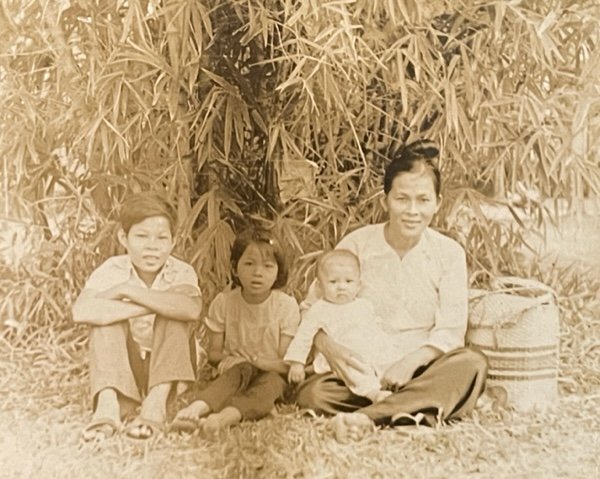
My brother Phuong, sister Cathy, and me in my mother’s arms in Saigon, Vietnam, 1977
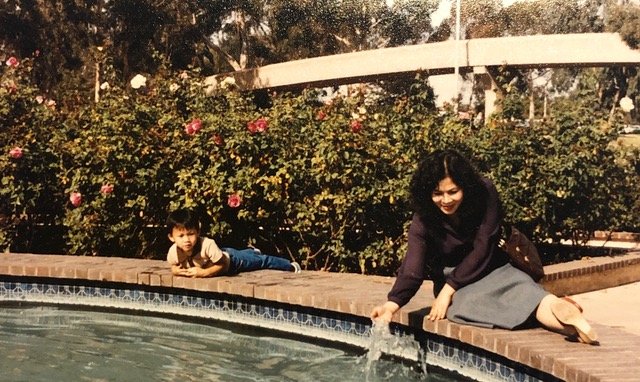
Me + Mom 1981, Balboa Park San Diego

Dad + Mom, in front of the van that was able to hold a dozen of us, 1982
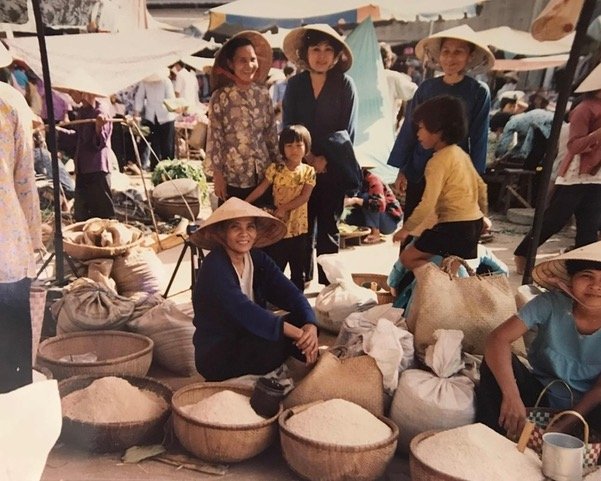
My mom surrounded by local rice growers in her village, Cau Ngang, Vietnam 2002
Living in the Diaspora, straddling three cultures, can be a lot to carry and live up to. My Vietnamese-American-Queer identity has its own complexities, but they all play a part in how I navigate my existence today. Balancing them concurrently is exhausting, emotionally and mentally taxing, but one cannot exist without the other. Therapy at a young age allowed me to be comfortable with my Queer American identity, but it held suggestions of my leaving my refugee baggage behind. I adopted this mentality in my late teens and early twenties, assuming I could fit in and navigate a young adult life. This performative existence did not suit me, and brought even more mental health struggles.
Tu Le with Ro Yoon
At age 24 I met the amazing, Ro Yoon, a confident queer Korean-American Transgender activist I connected with on many levels; through fashion, art, music and food, we were able to form a sibling-like bond because of our familiar tri-cultural experience. I was inspired to cook more Asian food, especially Vietnamese. Her presence encouraged me to accept the fact that my Vietnamese heritage was the most defining part of who I was.
I could never take my race off and blend into the world, no matter how much I suppressed my Vietnamese identity and altered my look, so why not wear it proudly? I got caught up in the need to “assimilate” game, and I almost lost who I was. I didn’t realize it at the time, but the connection with Ms. Yoon provided the enlightenment and care that I needed. The ritual of cooking and sharing food was something I had missed since leaving home as a teenager, and I had found a friend that I was able to share these parts of myself with.
Preparing and serving a meal is a fantastic way to connect with others. I learned through my mom, and elders, that food provides a lot of comfort and community. When I cook and share my table with others, I am sharing a piece of myself. My identity, and memories are all laid out there for others to take in. Sometimes all at it takes is simple bowl of Chao.
Cháo Trắng (rice porridge) serves 2-4
1/2 cup white rice (Jasmine preferred)
4-6 cups of water
1/2 tsp salt
Add all ingredients to medium pot, bring to boil. Reduce heat to med/low and allow to simmer. Skim foam and impurities that rise to surface and stir occasionally to prevent burning, cook for 20-25 minutes. The kind of rice you use will determine the consistency, I like enjoy a thinner consistency. Aborio and sushi rice are tougher and may take longer to cook. I prefer jasmine rice because the aroma bring back fond memories of childhood. I add soy sauce fermented cucumber or radish and peppered scrambled eggs. Garnish with cilantro and/or sliced green onions. Serve immediately.
Peppered Scrambled Eggs
2 eggs (room temp)
1 Tbsp soy sauce
1/2 tsp ground white pepper
1 Tbsp oil
Add oil to small saucepan over medium heat, crack eggs into heated pan. Using chopsticks or similar, gently whisk eggs to break up yoke and whites. When eggs are half way cooked, add soy sauce and turn off heat. Add pepper and continue to gently whisk for an additional 30 seconds. Serve immediately over Chao or on the side.
About the Author
The youngest of twelve, born in Phu Quoc, Vietnam, Tu Le is a first generation American farmer, florist, cook, storyteller, artist, activist and land steward. The owner of 328North, he has been farming on land he shares with his partner. Using the farm as his current medium, Tu connects with his Vietnamese Culture and shares that with his community from seed to chopstick.

